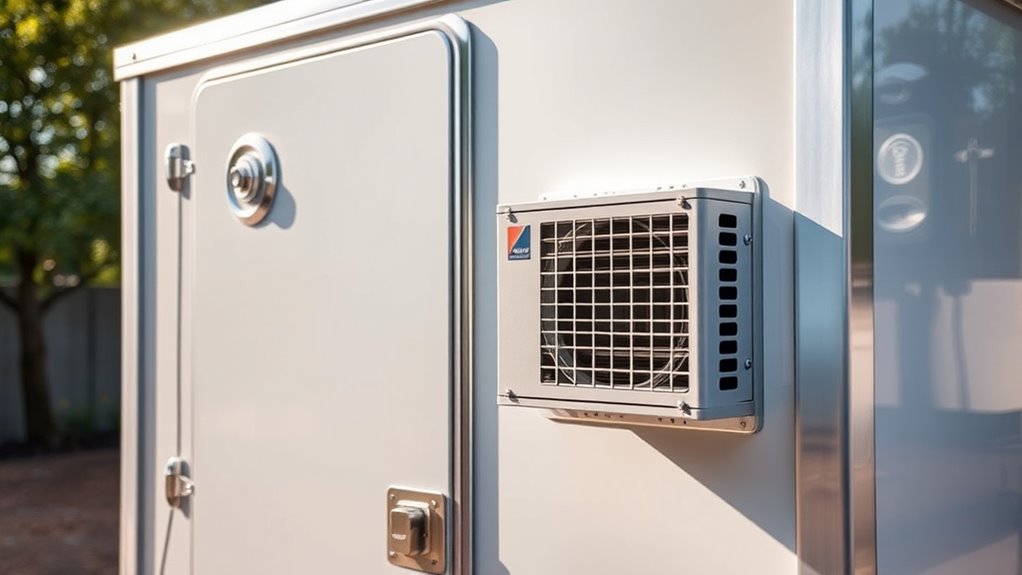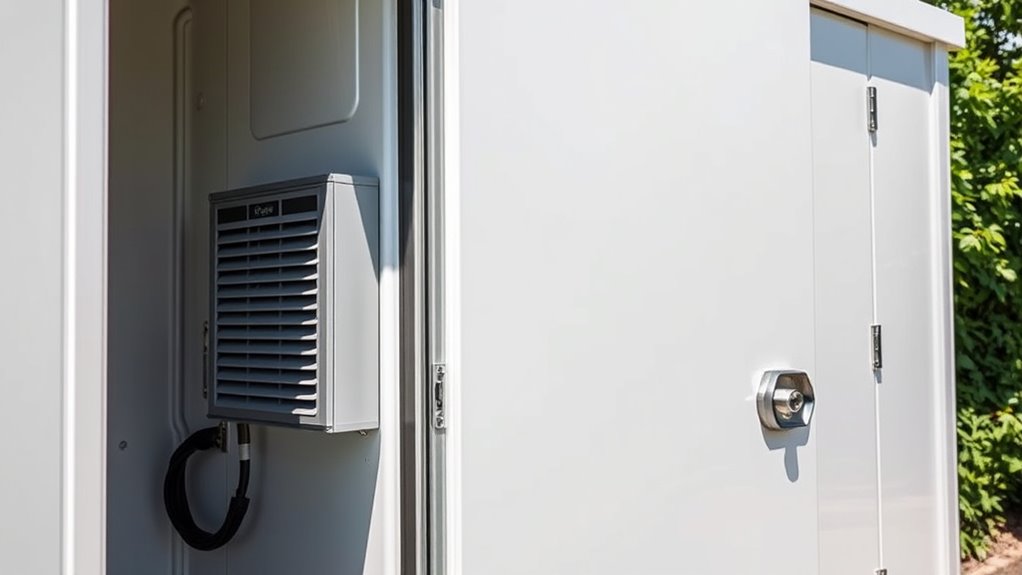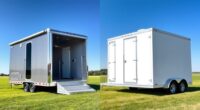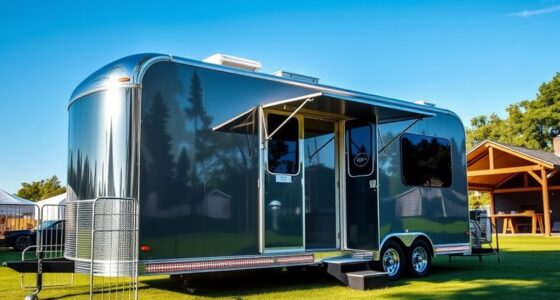To select the right HVAC system for premium portable restrooms, focus on options that provide adaptable ventilation, energy efficiency, and reliable performance. Choose compact units with features like adjustable airflow, smart sensors, and energy-saving components to control odors and maintain fresh air. Confirm the system meets industry standards and is easy to maintain for long-term durability. Discover more on how to optimize your setup for comfort and sustainability as you continue exploring your options.
Key Takeaways
- Choose ventilation systems that effectively control odors, humidity, and airflow while minimizing noise for user comfort.
- Prioritize energy-efficient HVAC units with smart features like programmable thermostats and variable speed fans to reduce operational costs.
- Select compact, lightweight, and durable units designed for mobile setups to ensure easy installation and maintenance.
- Opt for vetted and industry-standard solutions to guarantee reliability, safety, and consistent performance in various conditions.
- Balance functionality with sustainability by customizing HVAC solutions that enhance comfort, hygiene, and environmental responsibility.

Are you unsure how to choose the best HVAC system for portable restrooms? It’s a critical decision that impacts comfort, functionality, and overall user experience. The first thing to evaluate is the variety of ventilation options available. Proper ventilation isn’t just about air circulation; it’s essential for controlling odors, reducing humidity, and ensuring fresh air flows in and out efficiently. When selecting a ventilation system, look for options that can be easily adapted to different environmental conditions and that provide consistent airflow without excessive noise. Ventilation units with adjustable settings give you the flexibility to optimize airflow based on the number of users or specific weather conditions, making sure your portable restroom remains pleasant and odor-free.
Beyond ventilation, energy efficiency plays a pivotal role in your decision-making process. An energy-efficient HVAC system not only reduces operational costs but also minimizes your environmental impact. Modern systems are designed to consume less power while still delivering high-performance air circulation and temperature control. Features such as programmable thermostats, smart sensors, and variable speed fans help you regulate airflow and temperature precisely, avoiding unnecessary energy drain. This is especially important if your portable restrooms are used frequently or for extended periods. Investing in an HVAC system with high energy efficiency means you’ll save money over the long run and contribute to sustainability efforts.
When evaluating different HVAC options, pay attention to how well they integrate with your portable restroom setup. Compact, lightweight units are easier to install and maintain, but they shouldn’t compromise on ventilation quality or energy efficiency. Look for systems that are specifically designed for mobile or temporary structures, as these often have features optimized for those environments. Additionally, consider the system’s durability and ease of maintenance. An HVAC unit with accessible filters and straightforward controls will save you time and effort in the long run, ensuring your portable restrooms stay comfortable and hygienic.
Furthermore, selecting an HVAC system that incorporates vetted options ensures you receive reliable and tested solutions that meet industry standards. Ultimately, selecting the right HVAC system involves balancing effective ventilation options with energy efficiency. It’s about creating a comfortable environment while keeping costs manageable and reducing your ecological footprint. By carefully evaluating your specific needs and choosing a system tailored for portable restrooms, you’ll provide a better experience for users and streamline your maintenance process. Remember, a well-chosen HVAC setup doesn’t just improve comfort; it enhances the overall quality and reputation of your portable restroom facilities.
Frequently Asked Questions
How Does Climate Impact HVAC Choices for Portable Restrooms?
Climate substantially influences your HVAC choices for portable restrooms. In humid environments, you need systems that prioritize humidity control to prevent mold and discomfort. Cold climates require better insulation to maintain heat, while hot areas demand efficient cooling. Your selection should consider insulation requirements and humidity control features, ensuring the restroom remains comfortable regardless of weather. Properly matching HVAC to climate conditions guarantees ideal performance and user satisfaction.
What Maintenance Is Required for Portable Restroom HVAC Systems?
For portable restroom HVAC systems, you need to regularly check your vent filter and replace it as needed to guarantee proper air quality. Also, inspect the condensate drain to prevent blockages that can cause water buildup or leaks. Cleaning these components weekly keeps the system running efficiently, reduces odors, and extends its lifespan. Remember, consistent maintenance helps your HVAC system perform at its best and keeps your portable restrooms comfortable for users.
Are There Eco-Friendly HVAC Options Available for Portable Units?
Eco-friendly HVAC options for portable units include solar heating and geothermal cooling, which reduce energy consumption and environmental impact. You can choose solar-powered systems that harness sunlight for heating, or opt for geothermal cooling that uses the earth’s stable temperature to cool the restroom. These options are sustainable, cost-effective long-term, and perfect for environmentally conscious events, ensuring comfort while minimizing your carbon footprint.
How Does HVAC Size Affect Overall Portable Restroom Comfort?
Think of your restroom like a ship: the right HVAC size is your steering wheel. If it’s too big, you get unnecessary noise, disrupting comfort, and poor ventilation efficiency. Too small, and it struggles to maintain a pleasant environment. Proper sizing balances airflow and noise levels, ensuring a comfortable, well-ventilated space. When you choose wisely, you steer clear of discomfort, making your portable restroom a smooth, enjoyable experience.
What Are the Cost Implications of Different HVAC System Types?
You’ll find that HVAC system types differ in cost implications, especially regarding energy efficiency and installation costs. More energy-efficient systems might have higher upfront prices but save you money long-term through lower utility bills. Simpler systems tend to have lower installation costs but may not be as effective. Your choice impacts your budget, so weigh initial expenses against ongoing savings to determine the best fit for your portable restrooms.
Conclusion
Choosing the right HVAC system guarantees your portable restrooms stay comfortable and functional, no matter the weather. When you pick wisely, you’re not just putting a band-aid on the problem—you’re solving it at the root. Remember, “a stitch in time saves nine,” so invest in quality now to avoid bigger headaches later. With the right system, you’ll keep your guests happy and your operation running smoothly.









